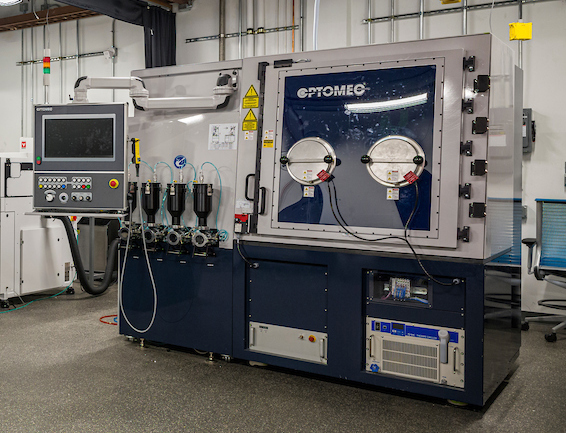BY AMANDA LYONS
Researchers in the UNT College of Engineering are participating in two projects funded by the U.S. Naval Research Office with separate grants totaling nearly $2.5 million. Both will use additive manufacturing to reach different goals.

Regents Professors Raj Banerjee and Narendra Dahotre with UNT’s Center for Agile and Adaptive Additive Manufacturing (CAAAM) will be studying the best process to create materials made of two or more different metal compositions with a nearly $1 million grant. They’re looking to combine materials via 3D printing on a gradient using machines like the Optomec LENS CS250 system, a laser machine that can combine between two to four different powder metal materials.
“Think of a component in a ship,” Banerjee says. “You want the outside to be resistant to seawater corrosion, but the inside might be near an engine, so it needs to be high-temperature resistant. We don’t have the same metal do both, but one side could be made of corrosion-resistant steel and the other could be nickel, with a gradient in between. 3D printing permits fabricating such next-generation naval components.”
Banerjee will examine the microstructures of the finished prototypes and how their properties change after 3D printing. Dahotre will study the changes in the metals as the printing is underway and run simulations to predict different results.
“I cannot push the next stage of printing without knowledge of the microstructures of these materials, and Raj cannot push the microstructures beyond current levels of understanding without the real and simulated process results,” says Dahotre, who is an internationally renowned expert in laser-based advanced manufacturing and a founding leader of CAAAM.
Their research is part of a larger multi-institutional project led by Iowa State University with collaboration from Pennsylvania State University as well. The lead team at Iowa State asked UNT to join the project in part because of the capabilities of CAAAM, which is changing the face of manufacturing by developing advanced material components for industries ranging from biomedical and energy to defense and aerospace. UNT’s unique microscopes in the Materials Research Facility (MRF) were a favorable factor as well.
“With our unique equipment, we can do the microscopy at a level not many universities can,” Dahotre says. “We have the expertise for it and we have a 3D printing center with intensive infrastructure. What we’re doing is not just imaginary, it has the potential to one day be implemented in all manufacturing.”
With an ever-increasing demand for a telecommuting option in today’s workforce, video calls that drop or lag can have a major impact on business operations. In environments with autonomous systems, such as disaster rescue areas, dropped linkages could be a matter of life or death. Associate professor Nigel Shepherd in materials science and engineering is researching how to create new electronic ceramic materials for advanced radio frequency applications using additive manufacturing methods.
“In the future, so much will be autonomous,” Shepherd says. “Latency must be eliminated, and the data transfer rate increased for simultaneous communications, sensing and situational awareness in real-time. The electronic ceramics we are developing will provide the required high speeds and handle the high powers that will enable autonomous, next generation systems.”
His award, which totals more than $1.46 million, is a collaboration between the U.S. Department of Defense’s Historically Black Colleges and Universities/Minority Institutions Program and Outreach, the Office of the Under Secretary of Defense for Research and Engineering (office S&TF2) and the Department of Navy’s HBCU/MI Program Office’s Distinguished Fellows Scholar fellowship.
As part of the fellowship, Shepherd will research full time with his team of graduate and undergraduate students. He’ll also collaborate with other researchers within the U.S. Department of Defense.
Like Banerjee and Dahotre, Shepherd is a core member of CAAAM and will use its unique capabilities for producing the materials using additive manufacturing. His goal is to develop and improve the process for creating electronic ceramics with optimal properties and performance for next generation radio frequency components such as antennas, filters and switches. As part of the project, he’ll use real-time materials characterization tools to track the materials’ evolution during the processing phase. These measurements will then be used to refine his computations and advance the processing science.
“The materials processing science is critical for manufacturing electronic ceramics that can provide the performance required for FutureG,” Shepherd says. “It’s a privilege to have been recognized by ONR with this fellowship, and of course, none of this would have been possible without the support of our superb CAAAM facility.”

